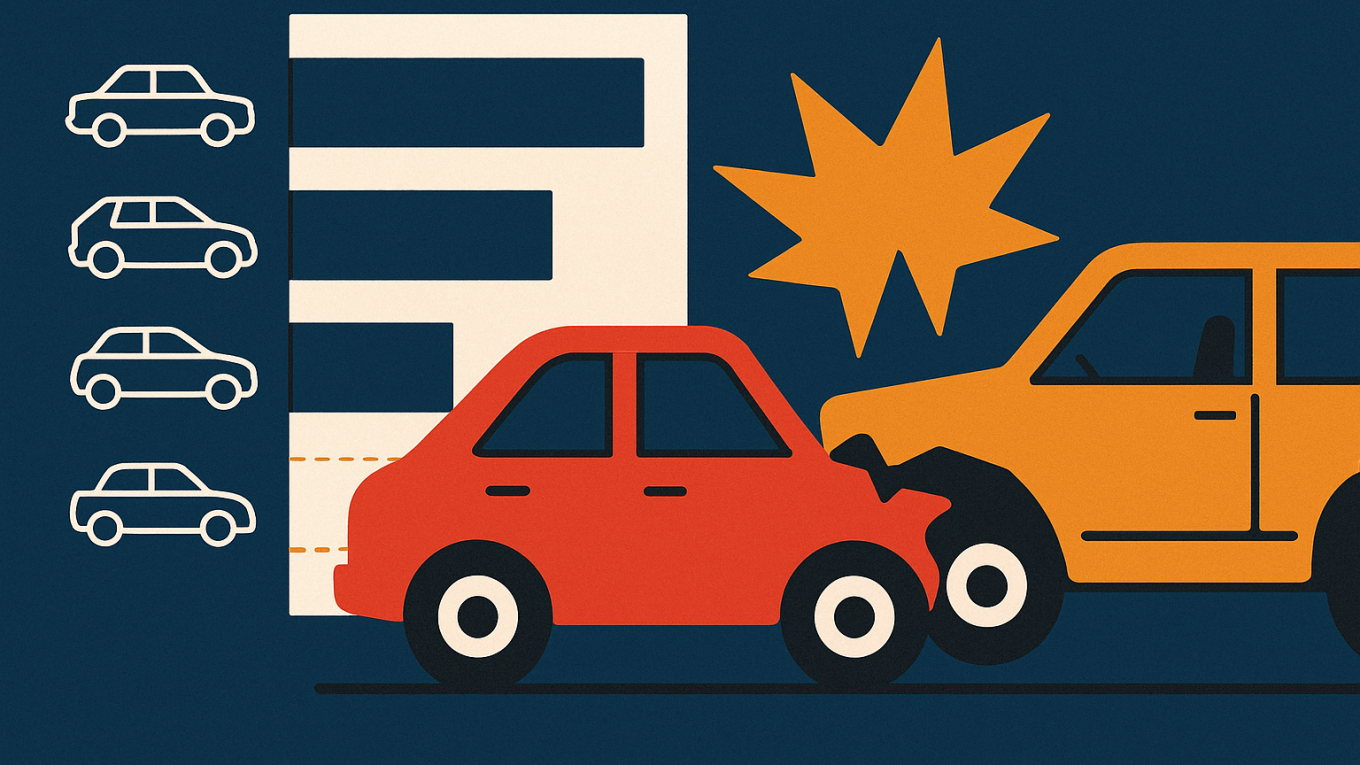Accident Frequency by Vehicle Make and Model
Over the past five years, studies have revealed clear patterns in accident frequency linked to specific car makes and models. While overall road safety has improved over decades, recent data shows a worrying uptick in crashes – for instance, U.S. traffic fatality rates rose about 15% from 2019 to 2023. Within this period, certain vehicles and brands consistently stand out for higher accident involvement. This article highlights the most accident-prone models, key trends in the data, and how factors like vehicle type, age, and region contribute to these patterns.
High-Risk Car Models and Brands
Multiple analyses indicate that a handful of models have significantly higher accident rates than the average vehicle. In terms of fatal crashes, an iSeeCars study (covering model years 2018–2022) identified the following models as the most dangerous on U.S. roads, each with fatal accident rates around five times the national average:
-
Hyundai Venue – Subcompact SUV: 13.9 fatal accidents per billion miles (≈4.9× the average).
-
Chevrolet Corvette – Sports car: 13.6 fatal accidents per billion miles (≈4.8× the average).
-
Mitsubishi Mirage – Compact car: 13.6 fatal accidents per billion miles (≈4.8× the average).
It’s notable that even high-tech electric cars made the list: the Tesla Model Y and Model S showed unusually high fatal crash rates despite advanced driver-assistance features. In fact, Tesla was found to have the highest overall fatal accident rate of any auto brand, followed (in order) by Kia, Buick, Dodge, and Hyundai. This suggests that a vehicle’s brand and design can correlate with serious crash outcomes, possibly due to factors like performance capabilities or driver profiles.
Looking at at-fault accident involvement (not just fatal crashes), insurance data provides another perspective on risky models. A 2023 analysis of 4.6 million insurance applications identified the Audi S4 (a high-performance luxury sedan) as having the most accident-prone drivers – about 11.7% of Audi S4 owners reported an at-fault accident, a rate roughly 54% higher than the national average. In fact, several of the top 10 accident-prone models are sports cars (e.g. Subaru WRX, Toyota GR86), but there are also economy cars on that list – indicating accident risk is not limited to high-performance vehicles; driver demographics and usage patterns play a role.
Brand-level insurance data echoes these findings. In 2022, RAM pickup owners had the highest at-fault accident rate (about 10.8%, or 17% above the national average), with Subaru drivers close behind (10.7%, ~16% above average). Volkswagen, Mazda, and Hyundai rounded out the top five brands with the most accident-prone drivers. Often it’s specific models within those brands – like the RAM 3500 or Hyundai’s sporty Veloster – driving up the rates. These patterns reinforce that who is behind the wheel is crucial: brands with more crashes also tend to have more speeding tickets among their drivers. Similarly, a 2024 analysis of overall driving incidents (accidents plus violations) also put Tesla, RAM, and Subaru as the top three brands with the highest incident rates per driver.
Factors Influencing Accident Rates
Several underlying factors help explain why some vehicles have more frequent accidents:
Vehicle Characteristics (Type & Age): The size, design, and age of a car significantly affect crash outcomes. Small cars, for example, have the highest fatal crash rate of any vehicle size category (about 3.6 fatalities per billion miles) due to less crash protection. Larger SUVs and pickup trucks generally protect occupants better, though they carry a higher rollover risk because of their higher center of gravity. High-performance models can encourage aggressive driving – sports cars like the Corvette or powerful sedans like the Audi S4 tend to be driven faster, which elevates crash likelihood. Additionally, older vehicles lack modern safety technology; driving a car more than 15 years old carries roughly a 31% higher risk of driver death in a crash compared to a car under 5 years old. This highlights how advanced safety features (stability control, automatic emergency braking, etc.) in newer cars help prevent accidents or reduce their severity.
Driver Behavior and Demographics: Human factors are often the decisive element in accident frequency. Certain cars attract higher-risk drivers – for instance, affordable sporty models (like the Subaru WRX or older Scion compacts) are popular with younger enthusiasts who statistically have more crashes. Across the board, studies show that speeding, distraction, and impairment contribute to most collisions. Brands with the highest accident rates also tend to have the most speeding-prone drivers, suggesting that driver habits (not just the vehicle itself) are a major cause of accidents. In short, even the safest car can be crash-prone in the hands of a reckless driver, whereas a high-powered sports car can be relatively safe if driven responsibly.
Usage Patterns and Environment: When, where, and how much a vehicle is driven also influence its accident risk. Urban driving involves heavy traffic and more interaction with other road users, leading to more frequent (though usually lower-severity) collisions – one analysis notes that urban areas generally see higher accident rates than rural areas. Rural driving, on the other hand, features open roads and higher speeds; while crashes are less frequent in rural areas, the per-mile fatal crash rate is significantly higher (rural drivers are about 44% more likely to die per mile traveled than urban drivers). High annual mileage increases exposure to risk as well. For example, a work truck or commuter car that logs many highway miles simply has more chances to be in an accident (which partly explains why models like the Silverado see higher collision counts). Weather and road conditions are additional environmental factors – slick roads, poor infrastructure, or nighttime driving can all raise accident likelihood for any vehicle.
Five-Year Trends and Safety Implications
In the early 2020s, U.S. traffic fatalities unexpectedly rose after years of decline – with a 12–15% spike in death rates from 2019 to 2022. This surge has been attributed to more reckless driving behaviors (such as speeding on emptier roads during the pandemic) among other factors. Notably, the specific car models and brands with high accident rates have remained fairly consistent over these years. Small, lightweight cars and high-performance models continue to top the lists of the most crash-prone vehicles (often with fatal crash rates several times the norm). Likewise, brands that cater to performance or that attract aggressive drivers have persistently higher accident involvement – the same names (Tesla, certain sports car makers, and even some truck brands) keep appearing in accident statistics. This suggests that the underlying risk factors – vehicle type and driver behavior – are ongoing issues rather than one-time anomalies.
On a positive note, newer vehicles are mitigating some risks. The spread of advanced safety technology (collision avoidance systems, lane assist, etc.) in the past five years is helping prevent or lessen crashes in many cases. Indeed, even the cars with the highest accident rates in recent analyses generally earn good crash-test ratings from the IIHS – indicating they are engineered well for safety. The difference often comes down to human factors. In fact, researchers conclude that driver behavior often matters more than the car itself when it comes to avoiding accidents. In other words, even a highly rated safe car can be involved in crashes if driven recklessly, while a powerful sports car can stay accident-free in the hands of a careful driver. These findings underscore the importance of driver education, sensible speed and hazard awareness, and strict enforcement of traffic laws in parallel with improvements in vehicle safety design.
Key Takeaways for Safer Roads
In summary, recent crash statistics confirm that certain vehicles – especially small, light or high-performance models – are involved in accidents at disproportionately high rates, while brands attracting aggressive drivers also see elevated crash frequencies. However, the data also makes clear that these outcomes stem from a combination of vehicle characteristics and human factors. By selecting safer vehicle designs (with modern safety features) and committing to responsible driving habits, motorists can substantially reduce their risk. Ultimately, improving road safety over the next five years and beyond will depend on both smarter vehicle engineering and smarter driver behavior working together.

